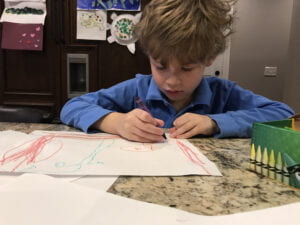
The occupation of handwriting has a universal quality as it spans history and languages. And yet, handwriting also has a very individual nature that is often laden with personal meaning and purpose. Unsurprisingly, after having countless conversations about handwriting with researchers, practitioners, teachers, parents, and children, I’ve found that everyone has had a personal story or question. Being able to effectively share what I have learned about handwriting and handwriting dysfunction, therefore, became an obvious goal.
Undoubtably, presenting at a state conference is a great way to reach a large and interested audience. For me, however, having always found more comfort and confidence behind a keyboard than behind a podium, the state conference poster that I presented was a more challenging undertaking than any other artifact in this ePortfolio. I feared that my ability to translate knowledge would be negatively impacted by my discomfort with public speaking. I found that while I enjoyed examining the content and creating the PowerPoint slides, recording the video was uncomfortable (and required many re-recordings before the final iteration was completed). Even though presenting is not an area where I excel, I am proud that my presentation was accepted for the Ohio Occupational Therapy Association’s conference and that it is currently in the public domain and available for anyone interested to view.
My next artifact, the Handwriting Intervention Primer, is a critical piece that adds to the totality of this ePortfolio. Understanding how to design interventions based on individual needs and contexts is “where the paint meets the canvas” (so to speak) and is certainly worthy information to share. The Handwriting Intervention Primer evolved from the desire to understand discrete and specific handwriting difficulties and cultivate appropriate, practical, and effective intervention strategies for practitioners. In my first edition of the primer, I described specific diagnoses that were commonly associated with handwriting dysfunction. This was the case, to be honest, because this is where a literature search sent me. I noticed that research tends to identify and link specific diagnoses with a higher prevalence of handwriting dysfunction. After reflection though, it made more sense to focus on how specific factors (e.g., motor planning) may impact certain handwriting anomalies (e.g., variable starting points or stroke trajectory). Producing the primer in this way, allows greater generalization and gears practitioners to closely examine specific handwriting difficulties in order to provide appropriate interventions.
Sharing knowledge is one of the most valuable aspects of becoming an expert. Fortunately, there are many ways to distribute knowledge; each avenue supporting its own characteristic merits and disadvantages. I might always veer away from public speaking as a way to share knowledge, but with each attempt I gain experience and build confidence for the next presentation.
______________________________________________________________________________________